This year, Samsung has broken new ground with its Galaxy S24 lineup, delivering not only the excellent year-over-year performance enhancements we’ve come to expect from Qualcomm’s flagship Snapdragon chips, but a whole new suite of Galaxy AI features that let you translate conversations, enhance your photos, summarize your notes, and more.
In the case of Samsung’s premium flagship, the Samsung Galaxy S24 Ultra, those are joined by a new titanium frame and some camera enhancements that change things up in interesting and exciting ways. Plus, the new Snapdragon 8 Gen 3 for Galaxy provides more than enough performance to spare.
On the other hand, those who have followed Google’s Pixel series of phones probably already know that the search giant is no stranger to AI-powered features. Google has been building custom Tensor series chips for a couple of years now, focusing on powering the machine learning capabilities that allow its phones to punch well above their weight class when it comes to photography.
Although the first two Tensor generations delivered on that promise, they often came up short in other areas. However, the Tensor G3 in last year’s Google Pixel 8 Pro impressed us with enough raw power to make it a more serious contender for those looking for top-notch gaming and multitasking performance. Does it have enough to take on Samsung’s extreme Galaxy S24 Ultra, especially now that Samsung is baking in similar AI to compete in Google’s arena? Let’s dig in and find out.
Galaxy S24 Ultra vs. Pixel 8 Pro: specs
| Samsung Galaxy S24 Ultra | Pixel 8 Pro | |
|---|---|---|
| Size | 162.56 x 78.99 x 8.64 mm (6.4 x 3.11 x 0.34 inches) | 162.6 x 76.5 x 8.8 mm (6.4 x 3.01 x 0.35 in) |
| Weight | 233 grams (8.22 ounces) | 213 grams (7.51 ounces) |
| Screen |
6.8-inch QHD+ Dynamic AMOLED 2X Display with Super Smooth 120Hz refresh rate (1~120Hz) |
6.7-inch LTPO OLED with 120Hz refresh rate and 1,600 nits brightness, 2,400 nits (peak) |
| Screen resolution |
3120 x 1440 pixels at 505 pixels per inch |
2992 x 1344 pixels at 489 pixels per inch |
| Operating system | Android 14 with One UI 6.1 | Android 14 |
| Storage | 256GB, 512GB, 1TB | 128GB, 256GB, 512GB, 1TB |
| MicroSD card slot | No | No |
| Processor | Snapdragon 8 Gen 3 for Galaxy | Google Tensor G3 |
| Camera | Rear: 200-megapixel (MP) main camera (wide), 12MP Ultrawide, 50MP 5X telephoto, 10MP 3x telephoto.
Front: 12MP |
Rear: 50-megapixel (MP) main camera (wide), 48MP ultrawide, 48MP 5X telephoto.
Front: 10.5MP |
| Video | UHD 8K (7680 x 4320) at 30 frames per second (fps), slow motion UHD at 120 fps, slow motion FHD at 240 fps | 4K at 60 frames per second (fps), 1080p at 240 fps |
| Cellular | 5G mmWave (U.S. models only), 5G (sub-6GHz), | 5G mmWave, sub-6GHz |
| Bluetooth version | Bluetooth 5.3 | Bluetooth 5.3 |
| Ports | USB-C | USB-C |
| Water resistance | IP68 | IP68 |
| Battery | 5,000 mAh with 45W wired fast charging, Fast Wireless Charging 2.0 and Wireless PowerShare | 5,050mAh with 30W wired fast charging and 23W wireless charging |
| Network support | All major carriers | All major carriers |
| Colors | Titanium Gray, Titanium Black, Titanium Violet, and Titanium Yellow, plus Samsung exclusive Titanium Blue, Titanium Green, and Titanium Orange | Obsidian black, Porcelain white, Bay Blue |
| Price | Starting at $1,300 | Starting at $999 |
Galaxy S24 Ultra vs. Pixel 8 Pro: design
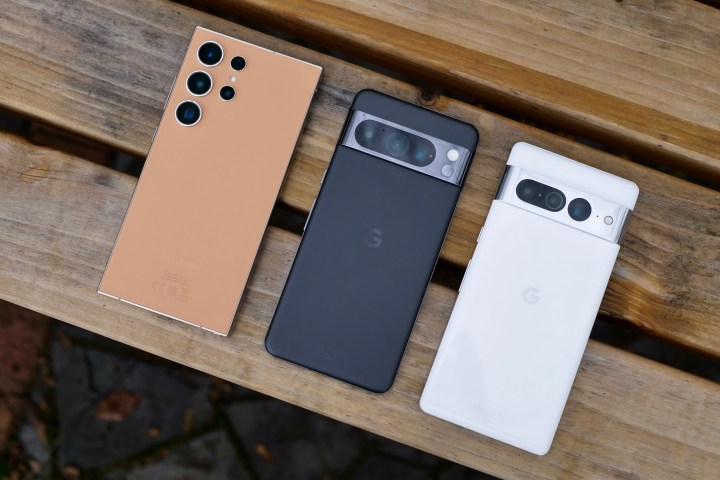
It’s fair to say that Samsung and Google have both developed their own iconic design languages over the past couple of years, with new models boasting evolutionary changes rather than revolutionary ones.
For Samsung, the Galaxy Ultra lineup dropped the classic camera bump two years ago in favor of letting the lenses stand on their own. It clearly liked that aesthetic, as it’s since brought it not only to the rest of the Galaxy S family, but even to its midrange and entry-level A-series phones. Hence, it’s no surprise that Samsung’s Galaxy S24 Ultra follows in the same footsteps.
However, that doesn’t mean nothing’s changed. This year, Samsung moved its flagship phone from its classic Armor Aluminum alloy to a titanium frame. While that technically allows it to shed a few grams, that’s not the real bonus here, as there’s a minimal weight difference between aluminum and titanium. Rather, the Galaxy S24 Ultra now gets a boost in durability, added scratch resistance, and a more attractive look. It also feels warmer to the touch and easier to keep a hold on. You may want to think twice about putting this one in a case.
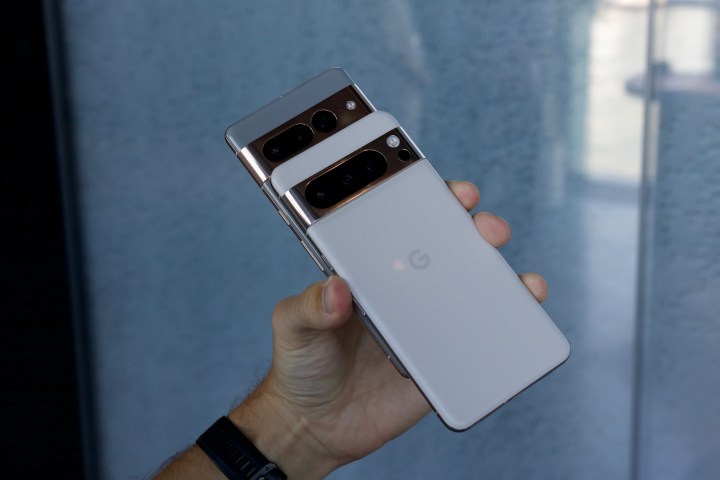
Similarly, Google’s Pixel 8 Pro can be tricky to distinguish from its predecessor at first glance unless you know what you’re looking for. It sports Google’s signature camera bar that helps set the Pixel family apart from other smartphones, but now combines the lenses into a single cutout. However, once you pick it up and look a bit closer, it’s clear Google has made some nice design refinements that add a touch of elegance and craftsmanship. The glass back is now matte, making it less of a fingerprint magnet, and it feels great in the hand, especially with the corners being more rounded.
While the Galaxy S24 Ultra technically comes in slightly larger and heftier with its 6.8-inch screen, it’s not significantly more so than the Pixel 8 Pro. We’re talking about 2.5 millimeters in width and 20 grams in weight; the extra tenth-of-an-inch for the display comes from narrower bezels on Samsung’s part, and any difference when holding the new phones can be chalked up to the different materials and designs used in each. Glass and titanium feel very different, and Samsung and Google have also gone in opposite directions with the edges, with the Pixel 8 Pro getting more curves while the Galaxy S24 Ultra gets less.
The Galaxy S24 Ultra does have an edge over the Pixel 8 Pro in terms of durability, with Samsung opting for Corning’s latest Gorilla Armor Glass this year. It’s more scratch-resistant and less reflective than last year’s Gorilla Glass Victus 2, which is still used on the Pixel 8 Pro. It’s unclear how much of a difference this makes in impact protection, but the reduced glare keeps the screen noticeably more visible when dealing with bright overhead lights or direct sunlight. Both phones also feature an IP68 rating for dust and water resistance. Samsung specifies up to 1.5 meters of protection for 30 minutes on the Galaxy S24 Ultra. While Google has never said precisely what its IP68 rating means, we expect it’s very similar, as IP68 has to offer more than one meter of water resistance for at least 30 minutes.
The Galaxy S24 Ultra and Pixel 8 Pro both feature stunning designs in their own ways, and while Samsung’s phone has some minor advantages with its newer Armor Glass, we don’t think those are enough to tilt the scales over what ultimately comes down to a personal choice for buyers.
Winner: Tie
Galaxy S24 Ultra vs. Pixel 8 Pro: display
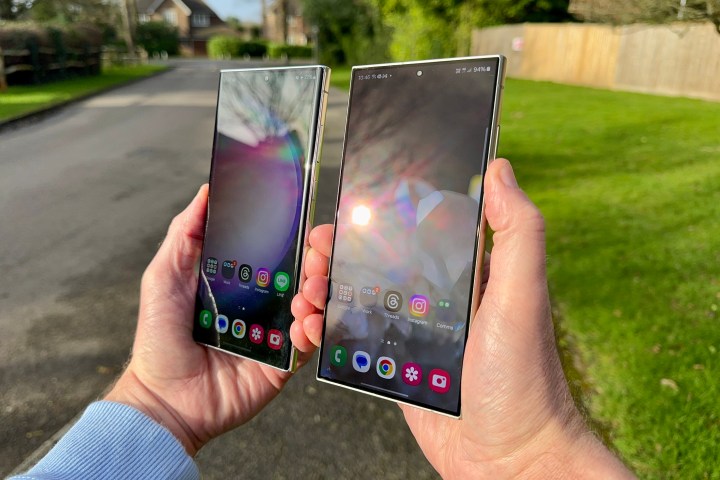
Samsung’s phones have always had some of the best AMOLED displays on the market, which is no surprise considering that Samsung has its own display division that produces a large percentage of the displays used on every phone on the market — including the Pixel 8 Pro.
However, Samsung naturally reserves its best displays for its smartphones, and the best of the best naturally land in its top-of-the-line Galaxy S24 Ultra. What you’re getting here isn’t a significant change from last year’s Galaxy S23 Ultra — it’s still a 6.8-inch AMOLED 2X panel with a 1Hz to 120Hz adaptive refresh rate and a negligible bump to a 3120 x 1440 resolution — but it’s gotten much brighter, with a new peak outdoor brightness of 2,600 nits.
We found that to be a noticeable increase from the 1,750 of the S23 Ultra, which, combined with the new Gorilla Armor Glass, makes the screen much easier to see on even the brightest days. The Adaptive Brightness also behaves well when working in bright light, avoiding the temptation to automatically dim your screen to save a bit of battery life.

Google’s Pixel 8 Pro has adopted a different display from its predecessor, which the company has dubbed its new “Super Actua” display. It’s an LTPO OLED screen with the same 120Hz variable refresh rate and always-on capabilities, but it’s pushes the outdoor brightness up to 2,400 nits. That was the best we’d seen on any smartphone when the Pixel 8 Pro was released; it’s naturally been leapfrogged by Samsung and others since, but it’s more of a paper chase now as we’re reaching the point of diminishing returns. Anything above 2,000 nits seems to be good enough for most outdoor use, and it’s unlikely you’ll notice much difference between Google’s 2,400 nits and Samsung’s 2,600 nits in raw brightness. If anything, Samsung’s new glass helps with outdoor visibility far more than those extra 200 nits.
Like Samsung, the biggest change in Google’s display is the increased brightness. It offers a 2992 x 1344 resolution for a density of 489 pixels per inch (ppi). That’s slightly lower than the 505 ppi on the Galaxy S24 Ultra, but it’s not a difference you’ll notice with the naked eye. However, the Pixel 8 Pro has another trick up its sleeve that helps narrow the gap with the S24 Ultra: it can now dial the refresh rate down to the same 1Hz, letting it use less battery power in always-on display mode.

Both displays deliver excellent quality, with deep, rich colors and crisp text, and we don’t think anyone will be disappointed with either. Still, Samsung gains a new edge with an improved always-on display that departs from the classic monochromatic look that’s graced most Android phones. Instead, it seems to have taken a page out of Apple’s book by allowing a more colorful view that allows you to keep a dimmed version of your wallpaper and notifications in view.
That became a polarizing feature when Apple introduced it — people seemed to either love it or hate it — and Apple eventually had to provide a way to turn it off. Samsung has learned from that, and it’s wisely offering that option out of the gate. You don’t have to use it if you don’t want to, but it’s hard to argue that it’s a nice option to have and makes the Galaxy S24 Ultra stand out from the pack.
Winner: Samsung Galaxy S24 Ultra
Galaxy S24 Ultra vs. Pixel 8 Pro: performance and battery
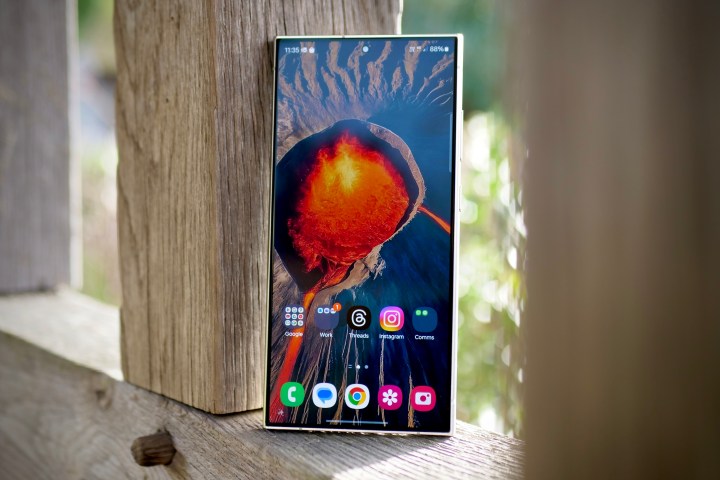
Samsung has once again worked with Qualcomm to bring its own bespoke version of the chipmaker’s latest flagship system-on-a-chip (SoC) to the Galaxy S24 Ultra. The Snapdragon 8 Gen 3 is already a ridiculously powerful chip, and Samsung’s Snapdragon 8 Gen 3 for Galaxy coaxes even more out of it for Samsung’s top-performing flagship and its One UI 6.1 flavor of Android. According to Qualcomm, that works out to a boost of 20% in the CPU and 26% in the GPU over last year’s Snapdragon 8 Gen 2 for Galaxy, compared to a 30% performance boost between the two non-Galaxy generations of the SoC.
Packing in 12GB of RAM across all of its storage configurations, the S24 Ultra not only had no problems handling the latest demanding mobile games, but also ran surprisingly cool, suggesting there’s power here to spare. For instance, we found that extended playtimes of games like Asphalt 9: Legends barely warmed things up; it took demanding benchmarking tests to make a noticeable difference, but the S24 Ultra never got too hot to handle.
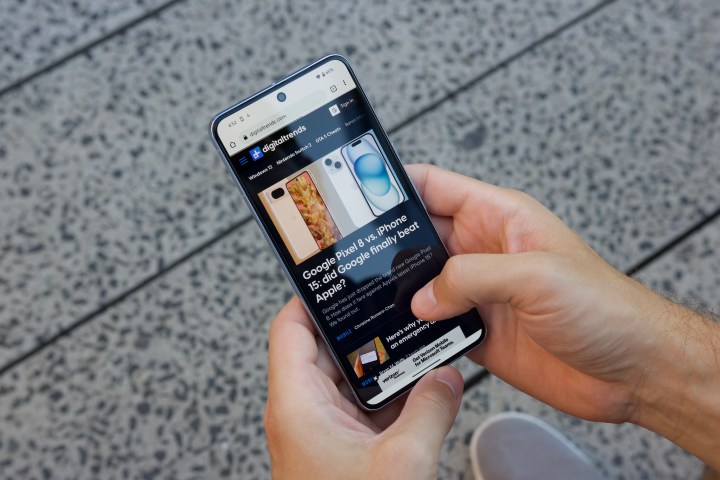
Unsurprisingly, Google’s Pixel 8 Pro still packs in one of the company’s own Tensor chips — a third-generation Tensor G3 in this case — but the good news is that Google has made some nice improvements to performance and thermal management compared to the previous iterations of the chip. In announcing the Tensor G3, Google promised that “every major subsystem has been upgraded,” which translates to a noticeable performance boost.
Can it hold its own against the Snapdragon 8 Gen 3 for Galaxy? Although the Tensor G3 doesn’t match the raw benchmarks on paper, in practical terms, we don’t think most folks will notice any difference worth caring about. The Pixel 8 Pro could handle everything we threw at it, including the latest demanding mobile games and multitasking between multiple apps. There was no stuttering or lagging, nor any of the overheating problems that plagued the Tensor G2-equipped Pixel 7 lineup. It seems Google has finally decided to shift away from its somewhat myopic focus on machine learning that hampered its previous Tensor chips.

We’re long past the point where raw power means much to the user-facing experience on flagship smartphones. Instead, the extra headroom provided by both the Snapdragon 8 Gen 3 for Galaxy and the Tensor G3 is there to power more sophisticated features like computational photography and AI. And this year, Qualcomm has changed that equation, moving onto Google’s turf by adding some sophisticated machine learning capabilities to its latest premium Snapdragon chip. We’ll talk more about those later.
If there area any areas where the Galaxy S24 Ultra is a clear winner, it’s in its battery life and charging performance. While the Pixel 8 Pro should get you through a full day thanks to the Tensor G3’s improved power efficiency, that still doesn’t hold a candle to the incredible stamina of the Galaxy S24 Ultra, which can end a busy day with 50% remaining, even after five hours of screen time used for gaming, video streaming, and calls. That’s despite both phones having similar-sized batteries (5,000mAh for the S24 Ultra and 5,050mAh for the Pixel 8 Pro), so it’s a testament to Samsung and Qualcomm’s power-management capabilities.
With its usual 45-watt charging, the Galaxy S24 Ultra still isn’t the fastest-charging smartphone on the market — that honor still goes to the OnePlus 12 — but it still beats out the Pixel 8 Pro’s 30W speeds. Practically, that works out to about a 20-minute difference in the time it takes to charge each phone from zero to full — 70 minutes for the S24 Ultra versus 90 minutes for the Pixel 8 Pro.
Winner: Samsung Galaxy S24 Ultra
Galaxy S24 Ultra vs. Pixel 8 Pro: cameras
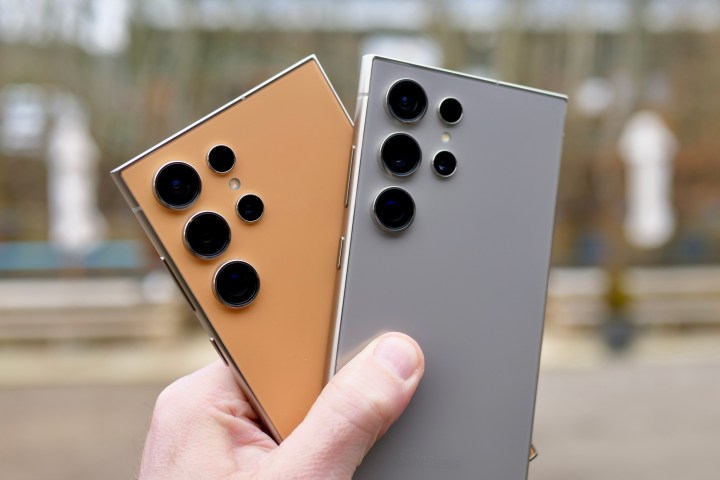
When it comes to cameras, Samsung puts the most premium camera hardware available into its Galaxy Ultra phones, while Google leans toward slightly above-average sensors driven by sophisticated computational photography algorithms.
The Galaxy S24 Ultra and Pixel 8 Pro both follow that trend, although each has been gradually encroaching into the other’s territory. This year, Samsung is taking advantage of the new AI and image-processing capabilities of the Snapdragon 8 Gen 3 to power new photo and video experiences, while also borrowing a page from some of its competitors by using pixel-cropping techniques to offer more optical-quality focal lengths. For its part, Google has packed some nice sensor upgrades into the Pixel 8 Pro to give the computational photography engine in its Tensor G3 more to work with.

The Galaxy S24 Ultra came with a change that surprised many folks at first blush: the elimination of its legendary 10x telephoto lens in favor of a 5x shooter. However, there was a method to Samsung’s seeming madness, as it also upped its best telephoto camera to a 50-megapixel (MP) sensor, a huge jump from the 10MP one on the S23 Ultra that not only delivers better quality images, but also still lets you capture 10x optical-quality shots with its Adaptive Pixel Sensor Technology. Of course, the digital zoom capabilities are all still here, with to a 100x “Space Zoom.”
Combined with the 3x telephoto lens, which remains mostly unchanged from last year, this provides Galaxy S24 Ultra owners with a new and arguably much more useful 5x zoom to play with since it’s entirely optical. As for the 10x zoom, technically you’ll only be shooting a 10MP photo in that mode, as Samsung is using a pixel-cropping technique to double the 5x zoom by using the center of the 50MP sensor, but that’s the same resolution the Galaxy S23 Ultra provided with its 10MP 10x telephoto camera, and the results speak for themselves.
Google’s Pixel 8 Pro has improved the sensors of its predecessor in light capture, with the main 50MP shooter promised to collect 21% more light and the two 48MP sensors in the telephoto and ultrawid, increasing that by 56% and 105%, respectively.

While those numbers may not look nearly as impressive as Samsung’s 200MP main sensor and dual telephoto lenses, the computational photography features of Google’s Tensor chips have always managed to produce exceptional results with relatively modest camera sensors. The Pixel 8 Pro effortlessly takes the kind of phenomenal photos we’ve come to expect from a Pixel phone. Colors are natural, balanced, and lively without being oversaturated, and there’s plenty of detail. For the company that pioneered night mode smartphone photography, it’s also no surprise that the Pixel 8 Pro still produces the best night mode photos you’ll find — and they’ve only gotten better with the increased light sensitivity of the cameras.
That’s not to say the Galaxy S24 Ultra is lacking in any meaningful way. If you want the best telephoto lens system you can get on a smartphone, and prefer photos that are more punchy, vibrant, and colorful, Samsung’s flagship is the phone for you. The good news is that Samsung also seems to have dialed the saturation down a bit compared to last year’s model, so while it’s not quite as ideally balanced as the Pixel 8 Pro, colors do look more natural.
The bottom line is that both phones take great pictures with different trade-offs. The Pixel 8 Pro will give you more natural hues and better lowlight and night shots, while the Galaxy S24 Ultra provides exceptional zoom capabilities with more vibrant colors that may not appeal to everyone.
Winner: Tie
Galaxy S24 Ultra vs. Pixel 8 Pro: software and updates
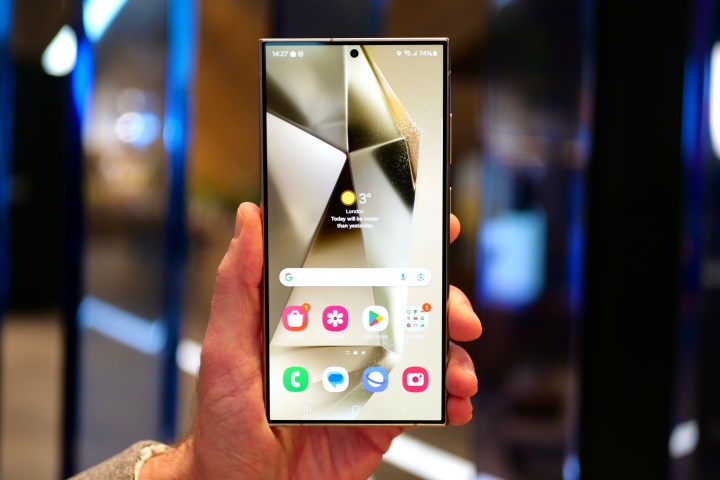
The Galaxy S24 Ultra and Pixel 8 Pro both ship with Android 14, although Google provides its usual “pure Google” experience while Samsung layers its One UI 6.1 on top. Each of these will appeal to a different audience, and despite the Pixel 8 Pro running just Android 14 sans any “skins,” it still packs in its own set of unique features specific to Google’s Pixel lineup.
However, Google raised the stakes last year when it promised a staggering seven years of Android updates and Pixel Feature Drops that will keep its latest flagship phone relevant until October 2030, when Android 21 comes along.
Not to be outdone, Samsung has followed suit, matching Google’s promise with its Galaxy S24 lineup, which should also take it to Android 21 and One UI 13.
Winner: Tie
Galaxy S24 Ultra vs. Pixel 8 Pro: special features

While Google’s Pixel lineup has been the undisputed king of AI features for the past few years, Samsung is throwing its hat into the ring with the Galaxy S24 Ultra and a new suite of Galaxy AI capabilities.
These primarily come thanks to the improvements in Qualcomm’s Snapdragon 8 Gen 3 chip, which has embraced machine learning in a big way. Samsung is leveraging these new capabilities to build new translation, transcription, and photo-editing features that could theoretically give Google a run for its money.
However, the key word here is “theoretically.” Google has a healthy head start in this area, both in software features and in the neural engines in its Tensor chips. By comparison, Samsung is a babe in the woods, and it shows with Galaxy AI.
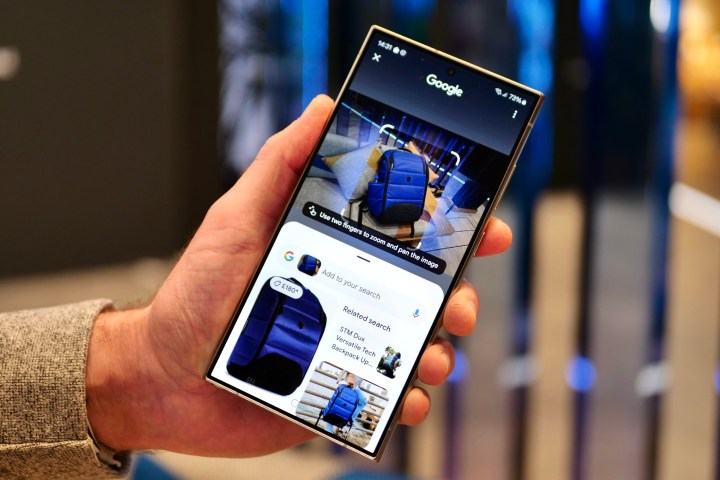
For example, one of the most compelling AI features on the Galaxy S24 Ultra is Circle to Search by Google, but that’s not an exclusive feature. As the name suggests, Google built it, so it was inevitable that it would come to the Pixel 8 Pro, along with some other cool generative AI enhancements for composing messages and transforming photos into stickers.
The Galaxy S24 Ultra also includes new Interpreter and Live Translate features that can translate both live in-person conversations and phone calls in real time, plus AI-generated summaries and transcriptions in Samsung Notes that can transcribe and translate voice recordings to text from multiple speakers.
The Galaxy S24 Ultra also gains some photo- and video-editing capabilities that can fill in backgrounds and suggest enhancements to images. An AI-assisted slow-motion mode can also turn a regular video into a slow-motion one by interpolating the missing frames needed to slow it down. It works well and lets you create more whimsical experiences by slowing down only selected portions.

Still, many of these are features that Google’s Pixel phones have had for a while in some form or another. Google’s Magic Eraser has become almost legendary, and this year, it bolstered it with Audio Magic Eraser to do the same for audio clips, plus a Magic Editor feature that goes beyond simply erasing objects to let you move them around and change the lightning.
Beyond photographic features, the Pixel 8 Pro also includes built-in proofreading tools in Gboard, object and pet recognition for the selfie camera, and the ability for Google Assistant to summarize a web page for you. Suffice it to say that Google will likely remain ahead of the curve on the AI side for a while, although Galaxy AI will at least help Samsung fans look less longingly at what they’re missing.
However, with all the hype around generative AI these days, it may be hard to believe there’s still more to a phone than just AI features. But the Galaxy S24 Ultra has at least one thing that makes it stand out from the pack in the form of its S Pen. It’s hard to beat for those who would rather jot their thoughts down on the expansive 6.8-inch screen than type them in.
Winner: Tie
Galaxy S24 Ultra vs. Pixel 8 Pro: price and availability
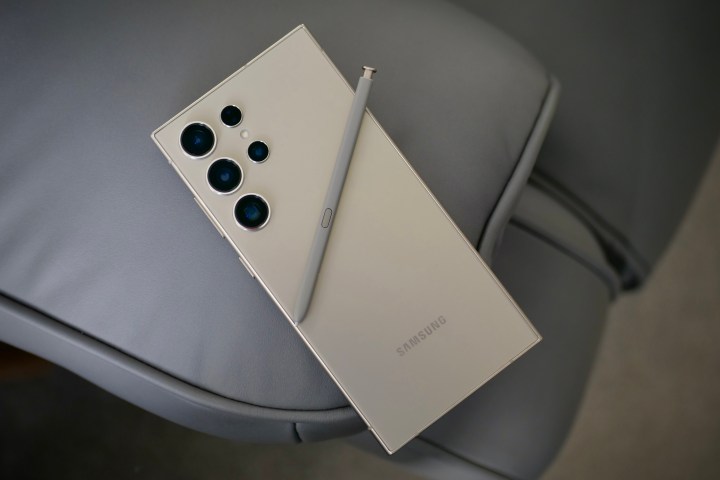
The Galaxy S24 Ultra comes in at $100 more this year, with the base 256GB model starting at $1,300. There are also higher 512GB and 1TB storage capacities available. You can find it at most major retailers and carriers in Titanium Gray, Titanium Black, Titanium Violet, and Titanium Yellow, with exclusive Titanium Blue, Titanium Green, and Titanium Orange colors available if you order directly from Samsung.
Google’s Pixel 8 Pro starts at a much more wallet-friendly $999, although that will only get you a 128GB model. However, you can move up to a comparable 256GB configuration for only $60 more. It’s available for purchase now from Google and other retailers and comes in Obsidian, Porcelain, and Bay colors.
Galaxy S24 Ultra vs. Pixel 8 Pro: verdict
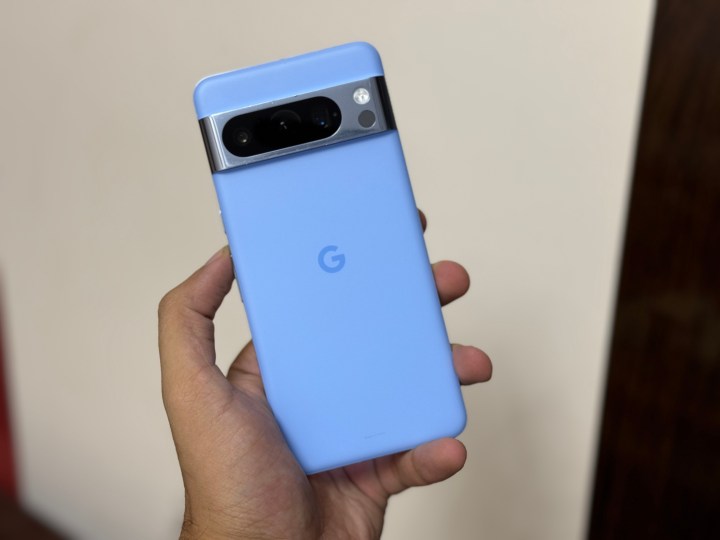
Even at the same price, the choice between Samsung’s Galaxy S24 Ultra and Google Pixel 8 Pro would be a tough call, but Google’s flagship has one essential thing going for it: It can be had for $300 less than Samsung’s beastly powerhouse.
At this price, we think the Pixel 8 Pro is the best flagship for most people. It takes excellent pictures under a wide range of conditions, the new Tensor G3 chip delivers the performance needed by everyone except the most hardcore mobile gamers, and Google also has a proven track record in delivering AI features that work well. The only significant knocks against the Pixel 8 Pro are its average battery life and slower charging; however, there’s still enough here to get most folks through a full day of use between charges.
None of that is to say that Samsung’s Galaxy S24 Ultra doesn’t have its own set of advantages. You get the best telephoto cameras available on any smartphone today with substantially longer-range zoom capabilities while still being able to capture outstanding photos. There’s also little doubt that the Snapdragon 8 Gen 3 chip can handle anything you throw at it without breaking a sweat — and it’s likely to provide that top-tier performance for another couple of years, even as new Android and One UI updates demand more from it. While the jury is still out on the Galaxy AI features and where the line is drawn between “useful” and “gimmick,” if you leave those aside, it’s still an ideal phone for those who want no-compromise performance and are willing to pay the premium to get it.
Editors’ Recommendations
